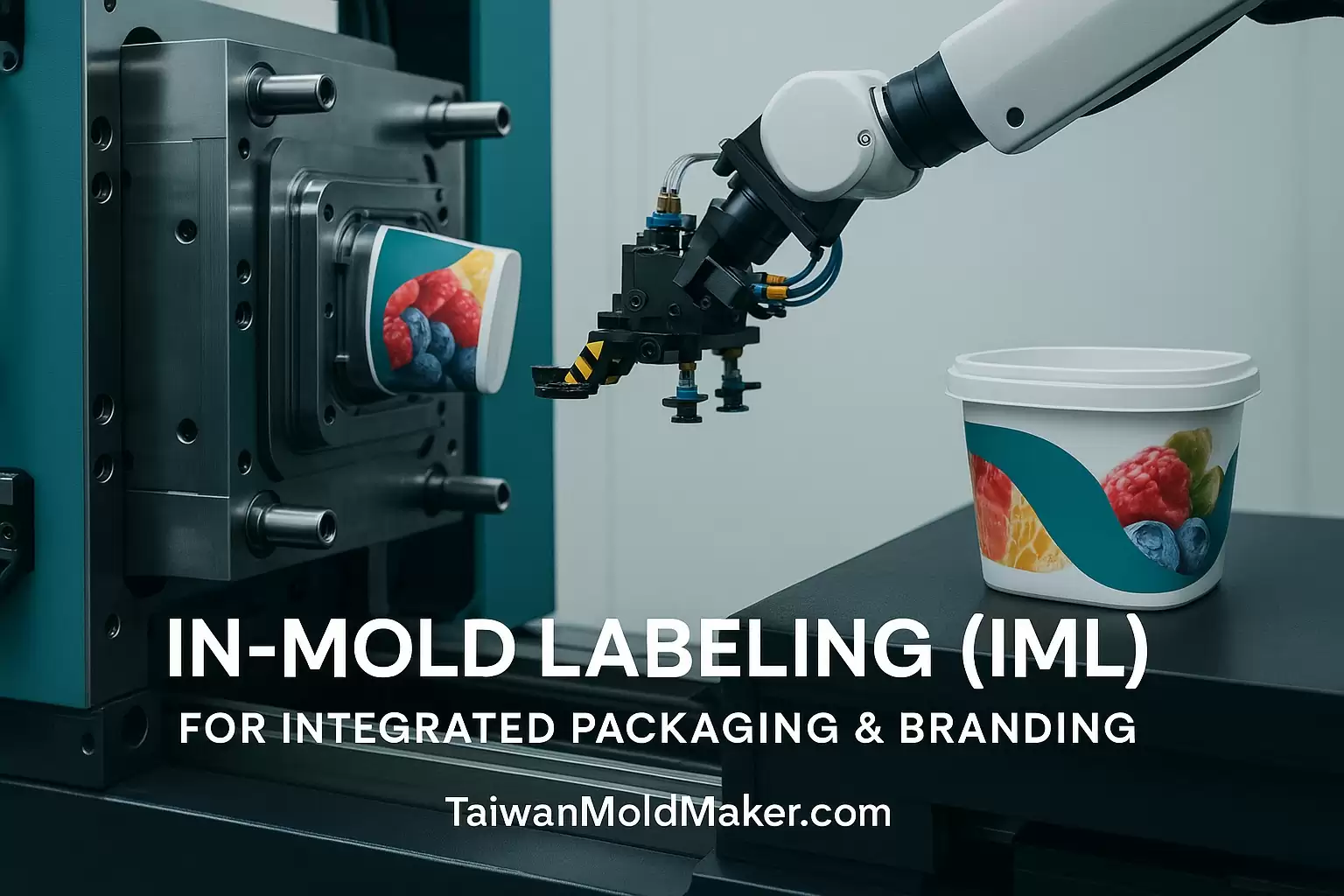Implement In-Mold Labeling (IML) Injection Molding for Integrated Packaging & Branding
Implement In-Mold Labeling (IML) Injection Molding for Integrated Packaging & Branding
If your pack needs to stand out on shelf and survive shipping, dishwashers, or outdoor use, in-mold labeling (IML) is the fastest route to a premium, fully integrated look. Instead of decorating after molding, a pre-printed label is placed in the cavity and becomes one with the part during injection—delivering scuff-resistant graphics, mono-material recyclability, and shorter total lead time. Here’s how to design, tool, and scale IML with the help of TaiwanMoldMaker.com.
Why IML Beats Post-Process Decoration
| Benefit | What It Means for You |
|---|---|
| Durable, premium finish | Graphics encapsulated under the plastic skin—resists scuffing, moisture, chemicals. |
| Fewer steps, faster launch | Molding and decoration happen in one cycle; no pad-print or label-apply stations. |
| Tight brand control | Photo-quality artwork, metallics, and textures aligned exactly to part geometry. |
| Sustainability | Mono-material PP IML parts are curbside-recyclable; no adhesive residue. |
| Cost at scale | Eliminates secondary labor; predictable cycle time with robotic label placement. |
IML Building Blocks—Materials & Label Types
-
Label Substrates:
-
PP (most common): 40–80 µm for thin-wall tubs, lids, closures.
-
PE: for squeeze surfaces; slightly lower stiffness.
-
Specialty films: metallic, holographic, or matte/soft-touch laminates.
-
-
Ink Systems & Primers: Low-migration, food-contact compliant options available; corona/chemical primed for strong fusion.
-
Perimeter Geometry: Flat, wraparound, or 3-D formed labels for deep cavities and complex contours.
Tip: For mono-material recycling, pair PP labels with PP parts wherever possible.
Design Guidelines for IML Parts
-
Wall Thickness: 0.6–1.0 mm for thin-wall packaging; 1.5–2.5 mm for lids/closures.
-
Radii & Corners: ≥ 0.5× wall to prevent label wrinkling and flow shadows.
-
Label Overlap: 1.0–1.5 mm; use micro-tabs or emboss features to hide seams.
-
Gate Strategy: Gate away from label edges; hot-runner valve gates minimize shear at the print face.
-
Texture & Gloss: Use mold textures (e.g., VDI 12–24) to control glare; matte films + micro-texture deliver a “paper-like” premium feel.
-
Anti-Warp Features: Balanced ribs under non-IML areas; maintain uniform cooling under large panels.
Process Window—Getting First-Shot-Right
-
Label Placement: Static charge or vacuum pins on EOAT; vision systems verify orientation before close.
-
Mold Temp: Typically higher than non-IML molding to improve fusion (e.g., PP 35–60 °C).
-
Melt Temp & Fill: Moderate-high speed to “wet” the label quickly without ink pick-off.
-
Hold & Pack: Enough pressure to eliminate voids at the label interface; avoid over-pack that telegraphs edges.
-
Cycle Time: Expect +0–2 s vs. non-IML when robotics and pre-stack magazines are optimized.
Tooling & Automation Essentials
-
EOAT Design: Vacuum cups shaped to artwork zones; anti-mark materials; integrated static bars.
-
Magazine Feeders: Pre-separate labels to avoid double picks; humidity-controlled cartridges.
-
Cavity Vents & Vacuum: Micro-venting around label edges prevents air traps; optional cavity vacuum improves lay-flat.
-
Hot Runner: Valve-gated with sequential timing for wraparound labels; balanced manifolds prevent color shift.
-
In-Cell QA: Vision SPC checks seam alignment, color register, and debris prior to eject.
Food, Home & Personal-Care—Where IML Shines
| Category | IML Part Examples | Why It Wins |
|---|---|---|
| Food & Beverage | Ice-cream tubs, yogurt lids, coffee canisters | Dishwasher-safe graphics, tamper cues, mono-material recycling |
| Home & Pet | Detergent closures, storage bins | Chemical & abrasion resistance during handling |
| Personal-Care | Cream jars, flip-top caps | Premium matte/metallic looks with scratch resistance |
| Electronics & Toys | Branded housings, themed bins | Photo-quality imagery with high impact durability |
Case Snapshot—1 L Thin-Wall Food Tub (PP+PP IML)
| Metric | Conventional Pad-Print | IML Workcell |
|---|---|---|
| Decoration Steps | Post-mold printing + handling | In-mold, one cycle |
| Line Throughput | 14,000 pcs/shift | 22,500 pcs/shift |
| Scuff Rejects (30-day) | 2.8 % | 0.6 % |
| Recycling Stream | Mixed materials | Mono-material PP |
Quality & Compliance, Baked In
-
Food-Contact Ready: Low-migration inks, lot COAs, migration testing support.
-
Traceability: MES ties cavity ID, label lot, ink batch to each carton.
-
Validation Packs: First-article, color ΔE, adhesion pull, drop/scuff, dishwasher and heat-cycle tests.
How TaiwanMoldMaker.com De-Risks IML
| Challenge | Our Built-In Solution |
|---|---|
| Label curling or bubbles | 48-Hour IML DFM Pack with label spec, pre-heat, and vacuum map |
| Wrinkles at corners | 3-D pre-formed labels + EOAT conformal support |
| Registration drift | Vision-guided pick & place; seam-tracking SPC |
| Cycle-time creep | Conformal-cooled cores; valve-gate sequencing |
| Duty exposure | Service-weighted billing—more value in engineering services, often duty-exempt |
One-Click Service Links
-
✔️ Mold Service
-
✔️ Molding
Fast-Track Engagement
-
Upload CAD & artwork files (STEP/IGES + PDF/AI).
-
Receive a 48-Hour IML DFM & cost pack—label spec, gate plan, cycle model.
-
Approve aluminum bridge tool + label die; get T-0 parts in 2–3 weeks.
-
Scale to multi-cavity steel with copy-cavity tooling and automated magazines.
Bring branding into the mold—and onto the shelf—without extra steps. Partner with TaiwanMoldMaker.com to implement IML injection molding that blends packaging, performance, and premium design in a single cycle.









